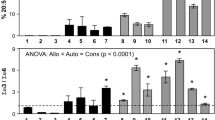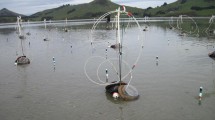Abstract
Herbivores mediate the abundances of primary producers both from the top-down, by consuming them, and from the bottom-up, by recycling nutrients. Whereas the top-down effects of herbivores on algae in marine ecosystems are well-documented, less is known about their roles as mediators of local-scale nutrient availability. We conducted a series of surveys and measurements of tide pools and the grazers in those pools between October of 2016 and June of 2017 at an intertidal site on the coast of Southern California, USA (33°35′16.3″N, 117°52′1.5″W). We surveyed grazer abundances in the field, measured biomass of representatives from four different grazer groups (littorine snails, limpets, chitons, and turban snails), measured ammonium excretion rates, and quantified ammonium accumulation rates in tide pools at our study site. We found that different grazer groups were characterized by different per-biomass ammonium excretion rates. Some grazer groups—turban snails and chitons—contributed more ammonium than predicted by their biomass, whereas other grazer groups—littorine snails and limpets—contributed less ammonium than predicted by biomass. Because of these differences between grazer groups, ammonium accumulation rates in tide pools at our study site were effectively predicted based on the ammonium excretion rates of the different grazer groups. However, ammonium accumulation rates were not related to total herbivore biomass. Our results highlight the importance of grazer identity—and particularly the role of species such as turban snails that contribute disproportionately to nutrient recycling—in understanding the contributions of grazers as mediators of bottom-up processes in marine systems.






Similar content being viewed by others
References
Adams A (1854) Descriptions of twenty-seven new species of shells from the collection of Hugh Cuming, Esq. Proc Zool Soc Lond 22:311–317. https://doi.org/10.1111/j.1469-7998.1854.tb07283.x
Aquilino KM, Bracken MES, Faubel MN, Stachowicz JJ (2009) Local-scale nutrient regeneration facilitates seaweed growth on wave-exposed rocky shores in an upwelling system. Limnol Oceanogr 54:309–317. https://doi.org/10.4319/lo.2009.54.1.0309
Best B (1964) Feeding activities of Tegula funebralis. Veliger 6(suppl):42–45
Bracken MES (2004) Invertebrate-mediated nutrient loading increases growth of an intertidal macroalga. J Phycol 40:1032–1041. https://doi.org/10.1111/j.1529-8817.2004.03106.x
Bracken MES, Nielsen KJ (2004) Diversity of intertidal macroalgae increases with nutrient loading by invertebrates. Ecology 85:2828–2836. https://doi.org/10.1890/03-0651
Bracken MES, Dolecal RE, Long JD (2014) Community context mediates the top-down vs. bottom-up effects of grazers on rocky shores. Ecology 95:1458–1463. https://doi.org/10.1890/13-2094.1d
Bray RN, Miller AC, Johnson S, Krause PR, Robertson DL, Westcott AM (1988) Ammonium excretion by macroinvertebrates and fishes on a subtidal rocky reef in southern California. Mar Biol 100:21–30. https://doi.org/10.1007/bf00392951
Burkepile DE, Allgeier JE, Shantz AA, Pritchard CE, Lemoine NP, Bhatti LH, Layman CA (2013) Nutrient supply from fishes facilitates macroalgae and suppresses corals in a Caribbean coral reef ecosystem. Sci Rep 3:1493. https://doi.org/10.1038/srep01493
Burnham KP, Anderson DR (2002) Model selection and inference: a practical information-theoretic approach, 2nd edn. Springer, New York
Carey N, Sigwart JD, Richards JG (2013) Economies of scaling: more evidence that allometry of metabolism is linked to activity, metabolic rate and habitat. J Exp Mar Biol Ecol 439:7–14. https://doi.org/10.1016/j.jembe.2012.10.013
Carpenter PP (1855) Descriptions of (supposed) new species and varieties of shells, from the Californian and west Mexican coasts, principally in the collection of Hugh Cuming, Esq. Proc Zool Soc Lond 23:228–235. https://doi.org/10.1111/j.1469-7998.1855.tb00330.x
Carpenter PP (1864) Supplementary report on the present state of our knowledge with regard to the Mollusca of the west coast of North America. Rep Br Assoc Adv Sci 33:517–686
Carpenter RC (1986) Partitioning herbivory and its effect on coral reef algal communities. Ecol Monogr 56:345–363. https://doi.org/10.2307/1942551
Castenholz RW (1961) The effect of grazing on marine littoral diatom populations. Ecology 42:783–794. https://doi.org/10.2307/1933507
Conrad TA (1837) Description of new marine shells, from Upper California, collected by Thomas Nuttall Esq. J Acad Nat Sci Phila 7:227–268
Corwith HL, Wheeler PA (2002) El Niño related variations in nutrient and chlorophyll distributions off Oregon. Prog Oceanogr 54:361–380. https://doi.org/10.1016/S0079-6611(02)00058-7
Duffy JE, Richardson JP, Canuel EA (2003) Grazer diversity effects on ecosystem functioning in seagrass beds. Ecol Lett 6:637–645. https://doi.org/10.1046/j.1461-0248.2003.00474.x
Duffy JE, Reynolds PL, Boström C, Coyer JA, Cusson M, Donadi S, Douglass JG, Eklöf JS, Engelen AH, Eriksson BK (2015) Biodiversity mediates top-down control in eelgrass ecosystems: a global comparative-experimental approach. Ecol Lett 18:696–705. https://doi.org/10.1111/ele.12448
Dunker G (1856) Mytilacea nova collection is Cumingianae. Proc Zool Soc Lond 24:358–366. https://doi.org/10.1111/j.1469-7998.1856.tb00343.x
Eklöf JS, Alsterberg C, Havenhand JN, Sundbäck K, Wood HL, Gamfeldt L (2012) Experimental climate change weakens the insurance effect of biodiversity. Ecol Lett 15:864–872. https://doi.org/10.1111/j.1461-0248.2012.01810.x
Flater D (1998) XTide v. 2.13. FlaterCo, Germantown
Giannotti AL, McGlathery KJ (2001) Consumption of Ulva lactuca (Chlorophyta) by the omnivorous mud snail Ilyanassa obsoleta (Say). J Phycol 37:209–215. https://doi.org/10.1046/j.1529-8817.2001.037002209.x
Glazier DS (2005) Beyond the ‘3/4-power law’: variation in the intra-and interspecific scaling of metabolic rate in animals. Biol Rev 80:611–662. https://doi.org/10.1111/j.1469-185X.2009.00095.x
Gould AA (1846) Description of new shells, collected by the United States exploring expedition, and belong to the genus Patella. Proc Boston Soc Nat Hist 2:148–152
Gould AA (1849) Descriptions of the following new species of shells, brought home by the US exploring expedition. Proc Boston Soc Nat Hist 3:83–85
Hawkins SJ, Watson DC, Hill AS, Harding SP, Kyriakides MA, Hutchinson S, Norton TA (1989) A comparison of feeding mechanisms in microphagous, herbivorous, intertidal prosobranchs in relation to resource partitioning. J Mollusc Stud 55:151–165. https://doi.org/10.1093/mollus/55.2.151
Kitching JA, Ebling FJ (1961) The ecology of Lough Ine: XI. The control of algae by Paracentrotus lividus (Echinoidea). J Anim Ecol 30:373–383. https://doi.org/10.2307/2304
LaScala-Gruenewald DE, Miller LP, Bracken MES, Allen BJ, Denny MW (2016) Quantifying the top-down effects of grazers on a rocky shore: selective grazing and the potential for competition. Mar Ecol Prog Ser 553:49–66. https://doi.org/10.3354/meps11774
Lawton JH (1994) What do species do in ecosystems? Oikos 71:367–374. https://doi.org/10.2307/3545824
Layman CA, Allgeier JE, Yeager LA, Stoner EW (2013) Thresholds of ecosystem response to nutrient enrichment from fish aggregations. Ecology 94:530–536. https://doi.org/10.1890/12-0705.1
Longphuirt SN, Lim J-H, Leynaert A, Claquin P, Choy E-J, Kang C-K, An S (2009) Dissolved inorganic nitrogen uptake by intertidal microphytobenthos: nutrient concentrations, light availability and migration. Mar Ecol Prog Ser 379:33–44. https://doi.org/10.1016/j.ecss.2007.04.025
Lubchenco J (1978) Plant species diversity in a marine intertidal community: importance of herbivore food preference and algal competitive abilities. Am Nat 112:23–39. https://doi.org/10.1086/283250
Martiny AC, Talarmin A, Mouginot C, Lee JA, Huang JS, Gellene AG, Caron DA (2016) Biogeochemical interactions control a temporal succession in the elemental composition of marine communities. Limnol Oceanogr 61:531–542. https://doi.org/10.1002/lno.10233
Matthiessen B, Gamfeldt L, Jonsson PR, Hillebrand H (2007) Effects of grazer richness and composition on algal biomass in a closed and open marine system. Ecology 88:178–187. https://doi.org/10.1890/0012-9658(2007)88%5b178:EOGRAC%5d2.0.CO;2
McIntyre PB, Jones LE, Flecker AS, Vanni MJ (2007) Fish extinctions alter nutrient recycling in tropical freshwaters. Proc Natl Acad Sci USA 104:4461–4466. https://doi.org/10.1073/pnas.0608148104
McIntyre PB, Flecker AS, Vanni MJ, Hood JM, Taylor BW, Thomas SA (2008) Fish distributions and nutrient cycling in streams: can fish create biogeochemical hotspots? Ecology 89:2335–2346. https://doi.org/10.1890/07-1552.1
Murray SN, Denis TG, Kido JS, Smith JR (1999) Human visitation and the frequency and potential effects of collecting on rocky intertidal populations in southern California marine reserves. Calif Coop Ocean Fish Investig Rep 40:100–106
Naeem S (2002) Ecosystem consequences of biodiversity loss: the evolution of a paradigm. Ecology 83:1537–1552. https://doi.org/10.1890/0012-9658(2002)083%5b1537:ECOBLT%5d2.0.CO;2
Nicotri ME (1977) Grazing effects of four marine intertidal herbivores on the microflora. Ecology 58:1020–1032. https://doi.org/10.2307/1936922
Nielsen KJ (2001) Bottom-up and top-down forces in tide pools: test of a food chain model in an intertidal community. Ecol Monogr 71:187–217. https://doi.org/10.1890/0012-9615(2001)071%5b0187:BUATDF%5d2.0.CO;2
O’Connor NE, Bracken MES, Crowe TP, Donohue I (2015) Nutrient enrichment alters the consequences of species loss. J Ecol 103:862–870. https://doi.org/10.1111/1365-2745.12415
O’Reilly WC, Olfe CB, Thomas J, Seymour RJ, Guza RT (2016) The California coastal wave monitoring and prediction system. Coast Eng 116:118–132. https://doi.org/10.1016/j.coastaleng.2016.06.005
Pfister CA (2007) Intertidal invertebrates locally enhance primary production. Ecology 88:1647–1653. https://doi.org/10.1890/06-1913.1
Reeve LA (1847) Monograph of the genus Chiton. In: Reeve LA (ed) Conchologia iconica, or, illustrations of the shells of molluscous animals, vol 4. Reeve, Benham, and Reeve, London
Ryther JH, Dunstan WM (1971) Nitrogen, phosphorus, and eutrophication in the coastal marine environment. Science 171:1008–1013. https://doi.org/10.1126/science.171.3975.1008
SAS Institute (2012) SAS version 9.4. SAS Institute, Cary
Solórzano L (1969) Determination of ammonia in natural waters by the phenolhypochlorite method. Limnol Oceanogr 14:799–801. https://doi.org/10.4319/lo.1969.14.5.0799
Stimpson W (1857) Notices of new species of Crustacea of western North America; being an abstract from a paper to be published in the Journal of the Society. Proc Bost Soc Nat Hist 6:84–89
Taylor RB, Rees TAV (1998) Excretory products of mobile epifauna as a nitrogen source for seaweeds. Limnol Oceanogr 43:600–606. https://doi.org/10.4319/lo.1998.43.4.0600
Williams SL, Bracken MES, Jones E (2013) Additive effects of physical stress and herbivores on intertidal seaweed biodiversity. Ecology 94:1089–1101. https://doi.org/10.1890/12-0401.1
Acknowledgements
We thank S. Bedgood, L. Elsberry, R. Fales, and B. Nguyen for field assistance and the City of Newport Beach for access to our study location. Funding was provided by the National Science Foundation (OCE 1736891 to M. Bracken and A. Martiny) and the UC Irvine Undergraduate Research Opportunities Program. We greatly appreciate the comments provided by P. Kraufvelin and two anonymous reviewers.
Funding
This research was made possible through funding provided by the University of California, Irvine, including an Undergraduate Research Opportunities Program award to J. Oates and A. Badten and a National Science Foundation Grant to M. Bracken and A. Martiny. The funders had no role in study design, data collection and analysis, decision to publish, or preparation of the manuscript. All applicable state and institutional guidelines for the care and use of animals were followed. All collections were made under California Department of Fish and Wildlife Scientific Collecting Permit SCP-13405.
Author information
Authors and Affiliations
Corresponding author
Ethics declarations
Conflict of interest
The authors declare that they have no conflicts of interest.
Additional information
Responsible Editor: P. Kraufvelin.
Reviewed by undisclosed experts.
Rights and permissions
About this article
Cite this article
Bracken, M.E.S., Oates, J.M., Badten, A.J. et al. Predicting rates of consumer-mediated nutrient cycling by a diverse herbivore assemblage. Mar Biol 165, 165 (2018). https://doi.org/10.1007/s00227-018-3422-z
Received:
Accepted:
Published:
DOI: https://doi.org/10.1007/s00227-018-3422-z




